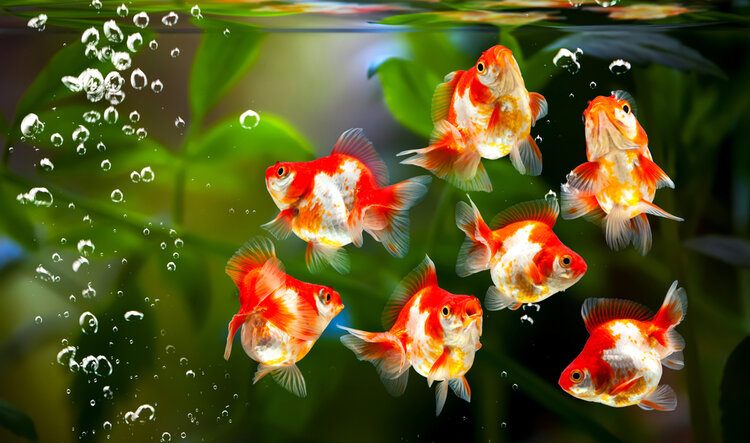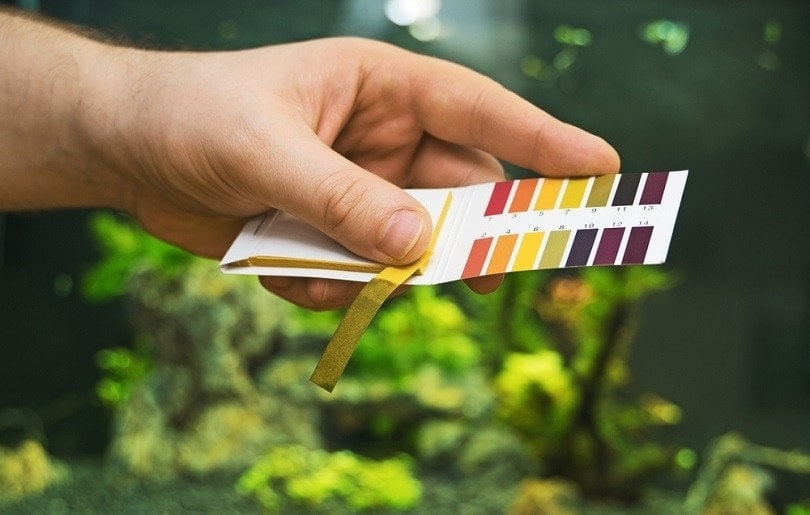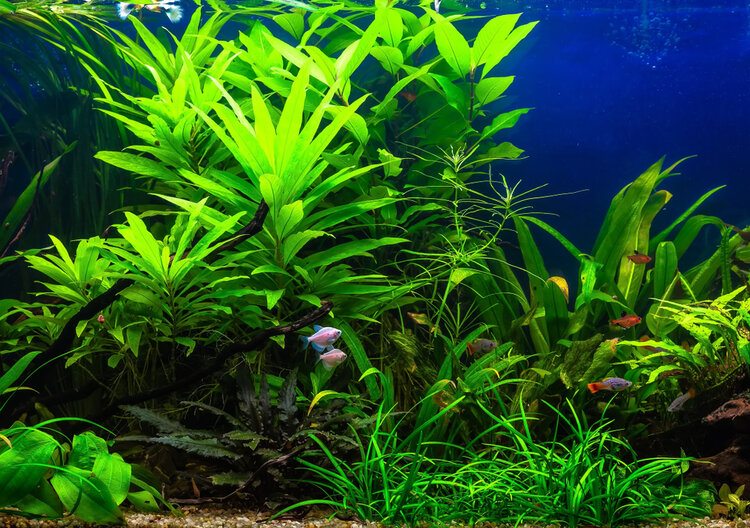Freshwater Refugium Filters for Goldfish & Other Aquariums

Updated on

The concept of “refugium” is relatively foreign to most freshwater fish keepers. But they can have an important role in your tank! Today I’m here to talk about the advantages of having a refugium, even a small one, on your freshwater setup.
Whether you keep goldfish and other kinds of fish, this is something you should know about. Let’s get into it!
Why Have a Freshwater Refugium Filter?
Here’s an example of a beautiful freshwater refugium setup:
I just love how it’s so peaceful. They make such amazing filters for goldfish tanks (or just about any other kind of freshwater fish filter). And here’s why:
1. Possibility to Make the Tank Self-Sustaining
The ultimate goal of an effective refugium setup is to help make the tank partially or entirely self-sustaining. This means far less maintenance on your part. Some report the reduced workload of doing a water change once a month or even once every several months.
The more self-sustaining your aquarium is, the less work for you. You can even enjoy having more aquariums!
2. Nitrate Reduction
Most filters are designed to remove ammonia and nitrite. But what about nitrate? Anaerobic filtration is best accomplished in a deep, dark area with a slow flow rate.
The bottom of a refugium equipped with plants is the perfect environment for this. You can even use Seachem Matrix or Aragonite for nitrate reduction and replenishing alkalinity.

If you are new to fishkeeping or simply confused about nitrites vs nitrates and everything in between, you should check out our best-selling book, The Truth About Goldfish. It covers everything from water treatments to aeration, proper tank setup, and so much more!
3. Fish Separation
The possibilities that refugiums create are not limited to just filtration. You can safely keep fish of different sizes/types all in one system. If you have a problem where one of your tank’s inhabitants is getting picked on, it’s a low-stress solution to get them to safety.
Did your fish just have babies, and you need a cycled place to house the eggs and grow out the fry? Their water will continue to be filtered and heated, but they will be separate from the main tank.
It’s a way to keep the water as clean as your main tank – with less work. Want to keep some more delicate species (animals or plants) that would be lunch in with your goldfish (such as loaches, small shrimp, snails, bettas, frogs… the list is endless)?
If the purpose of your refugium is to filter the water, I wouldn’t suggest keeping fish in it (more poop!). Also, as a quarantine tank for sick fish (injured ones would be fine), it’s not recommended to have connected systems as it can transmit disease.
4. Biodiversity
Refugiums are used to house tiny animal life, such as little shrimp (i.e. ghost shrimp, cherry shrimp), small snails (such as mini ramshorn, bladder), copepods, and microscopic worms. These little creatures improve the tank’s biodiversity – replicating a natural ecosystem.
Here’s my Amano shrimp/snail HOB refugium first set up:
And after just 2 weeks since I took this photo (the Pearl Weed has literally doubled in size!):
Currently, I have Ramshorn & Bladder snails with Pearl Weed (I do NOT keep the lights on 24/7 for this as it would stress the shrimp). What I love about this is while the snails lay eggs constantly, the snails are a delicious treat for my goldfish.
Feeding the extras to my hungry goldies not only prevents overpopulation but gives them a nutritious natural foraging source right there on the tank. The same is true of the plants.
Biodiversity helps your tank be more balanced and favorable to healthy fish. Where do they come from? The larger ones are introduced by you as the fishkeeper (shrimp, snails.)
The microscopic ones arrive much like the bacteria in your filter— seemingly out of thin air.
As time goes on, the biodiversity increases.

5. Toxin Absorption
The mud at the bottom of a refugium plays a special role in removing toxins from the water. Many of these toxins are from the water source itself.
6. Hiding Stuff
This is a benefit of using a larger refugium. You can pack some of your more unsightly equipment in it and free up the display tank. UV sterilizer, alkalinity replenisher, heaters, extra sponge filters, or other internal filters—just about whatever you can think of.
7. Greater Stocking Capacity
Refugiums can support a greater bioload than most other kinds of filters due to their nitrate reduction and waste processing capabilities.
What You Need
Plants
I just can’t see doing a refugium without plants. Live plants play a HUGE role in purifying the water in a fuge. You can use any fast-growing plant, and you don’t have to worry about it getting eaten. It’s totally protected.
Some good options are:
If you grow plants that your fish would eat, that’s even better because you can feed the pruning remains to your fish! Pruning it is important (and will be needed if your plant is happy).

Lighting
You will need lighting. Without it, your plants won’t grow quickly. I recommend the FugeRay LED or StingRAY LED. You can get it together with their awesome HOB refugium here for the best deal.
By default, it comes with an adjustable water pump, but you can also use an airstone if you prefer a lower flow and don’t mind the extra noise. Either way, it will work fantastic.
These lights should ideally be left on 24/7 for maximum performance. The way to accomplish this without disturbing your fish (for a HOB or behind tank setup) would be to have a dark aquarium background that blocks out the majority of the light and set it to “moonlight” at night.
Mud
Some use sand for their refugiums, but the general consensus is mud is the way to go. In a goldfish tank as a substrate, a mud bottom would make a disgusting mess with them plowing through it all the time.
Your tank would be in a constant brown fog. But mud has so many benefits, such as nitrate reduction, fish color enhancement, and remineralizing the water! This means fewer water changes.
Plants also love it. Through the use of a refugium (either in a sump or a HOB refugium), you can have mud in a low-current zone totally separate from fish that would stir it up.
1-2″ of dry-packed mud is recommended. What is the best kind of mud to use? Freshwater Miracle Mud is specifically formulated for refugiums. I would like to try half topsoil and half calcium bentonite clay mix to see how it goes. I will update you on how that works out.
Here are instructions on how to add it.
Half of the mud should be changed out once a year to replenish the minerals and replenish its function. One nice thing about refugiums is you can add some porous rock such as Seachem Matrix or Aragonite (to replenish alkalinity) and further assist in nitrate reduction.
This can be as simple or as complicated as well as beautiful or as unsightly as you want it to be. The bottom line? Water needs to be able to go in one side and out the other.
Fish from your main display tank should not be able to have access to it. The bigger it is, the better of a filter it will make and the more fish you can house in it (if you want to use it to house fish). More on what styles of refugiums you can use later.

How it Works
Water is slowly moved into an isolated chamber that contains a mud bottom, plants, and possibly tiny creatures like snails. This gentle current creates the perfect environment for nitrate reduction deep in the mud bottom and helps the plants suck up nutrients.
The purified water is then returned to the main tank. Keep reading to learn how to set it up.
The 3 Main Ways to Set Up A Refugium Filter
There are three ways I’ve found to set up a refugium. Method one is the easier option and probably the most affordable. It is great if you have very limited space. Method three is best if you have a larger surface area for your tank to rest on.
Method three is the largest (therefore the most powerful) but is not for novices. You will also need to either do a ton of research and planning to create a DIY version or spend a hefty chunk on a pre-made solution. Let’s start with method one.
Option 1 [Easy/Affordable]: Small HOB Refugium
Pros: Hurt/aggressive fish isolation, protecting eggs and baby fish, water remineralization
Cons: Smaller size means less effective filtration, limited storage for plants, and less nitrate reduction.
For those who don’t want to spend a lot of money or understand a lot of technical stuff, I’ve found the solution.
The HOB refugium. It sits behind the tank and is crystal clear, so you can see your fish. And if you don’t want to see it, no problem – all you need is a tank background or grow some tall plants in the back of the tank. This is totally a personal preference thing.
They make refugiums that stay completely inside the tank, but personally, I’m not as crazy about these (too distracting and take up space if they’re big enough to do anything). I really like the Finnex External Refugium/Breeder Box.
It holds 0.8 gallons and is good for a tank of 40−50 gallons. If you want to save money, you can go for Marina’s Hang on Breeding Box and do like other fishkeepers have done and convert it into a refugium for my 10-gallon tank.
It’s a bit more cost-effective and is powered by an air pump rather than a water pump (though you can use a water pump with a bit of modification). For lighting, I use this nifty little plant-growing light.

Option 2: Side-By-Side Tank Refugium
This method allows for much more water volume and filtration capabilities. More water, more plants, and more surface area for mud to do its nitrifying and nitrate-removing thing. It doesn’t get much better than that!
Here’s how it works: one tank is placed behind or next to the other. It’s okay if the refugium tank is smaller than the main tank, but the height of both tanks must be the same for this to work as described without flooding.
This can be done by propping up the smaller tank with bricks or boards – or something nicer if you can find it. Warning: If one pump starts failing or shuts off entirely, you WILL have a flood with this method.
Two identical submersible water pumps are needed (one to go in the main tank and one to go in the refugium), each with an adapter for the prefilter sponge on the intake.
Why sponges? The sponge on the main tank’s pump prevents debris from going into the fuge. The sponge on the refugium’s pump prevents little critters from getting into your main system (this could be anything from shrimp, snails, or fry).
Rubber tubing is also required to connect them – transferring water from one to the other. This will be connected to the outlets of the pumps. A plastic loop is useful to run into the fuge from the rubber tube on the main tank.
A spray bar is recommended for the return from the fuge to distribute the current. Don’t forget the light! Now, you might be thinking, “Why not just use a bigger tank instead of two smaller ones?”
Yes, you combine water volume, so it is like having a bigger tank in that respect. But one tank, the fuge, is primarily for filtration. A separate tank altogether has these important advantages:
- A 24/7 photoperiod is required for the fuge to perform at its best. If your main tank’s lights were on all the time, it would stress your fish. With a separate tank, you can block out the excess light with a tank background or cloth.
- It can be hidden behind the main display tank like a HOB. This is not possible if you only use one tank.
- No need to use silicone and dividers to section off part of your main tank, which not only is a hassle but looks unsightly.
Option 3 [Advanced]: Sump
Wet/dry sumps located under your tank can be designed to hold refugiums. These definitely have their advantages, such as being able to add a sock to catch debris and adding a lot of extra gallons to the tank’s overall volume.
Now, what is the problem with sumps? They are expensive and can be VERY COMPLICATED to set up. For starters, you need to either drill the tank (yikes!) or use an expensive overflow box to prevent spills in case of a power outage.
It requires a LOT of planning and researching and, at this point in my life, is beyond my paygrade to explain. If you can or want to do it, great. I think if you have a large tank and want an efficient filtration option that really cuts down on your water changes, go for it.
The following video provides a lot of detail about a Discus refugium sump setup. Some fish keepers have Discus, a species of fish that is extremely delicate and needs perfect water quality (kind of like some of the more fragile fancy goldfish).
Conclusion
I hope you learned something new in this post. The concept of a refugium filter is certainly fascinating to me (maybe that rubbed off?). What are your thoughts?
Feel free to leave a comment to let me know.
Featured Image Credit: panpilai paipa, Shutterstock











